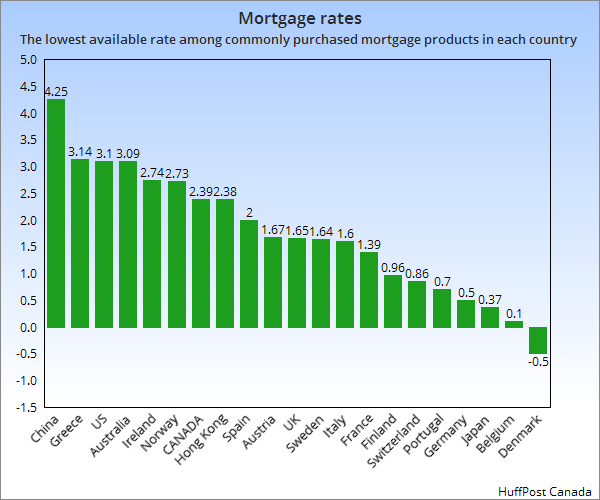
Canadian mortgage rates have been coming down and that has been a big boost to housing markets in recent months.
With lower monthly costs, more people can afford to buy, and that’s probably the main reason home sales soared 24 per cent in Toronto and Vancouver in July.
With fixed-rate mortgages going for as little as 2.39 per cent in Canada these days, you would think it couldn’t get any cheaper to borrow. But you’d be wrong.
Watch: The best communities in Canada for housing. Story continues below.
Looking at mortgages rates around the world, it now appears Canadians are paying higher-than-normal mortgage rates, with only a handful of developed countries ― including the U.S. and Australia ― seeing higher rates than Canada.
In the most extreme example, Denmark’s Jyske Bank is offering a fixed-rate mortgage at minus-0.5 per cent, essentially refunding borrowers 0.5 per cent of the mortgage’s value every year.
It’s not quite that crazy everywhere (yet), but in Japan and many European countries, mortgage rates are now below 1 per cent.

The chart above shows the lowest available rate among commonly bought mortgage products in each country. It’s not an apples to apples comparison, because the terms and lengths of mortgages vary widely from country to county. But it shows what you could get if your one goal was to lock in the lowest rate.
So what’s going on?
Global investors are worried about a possible recession, and their nervousness is pushing down interest rates around the world. The interest paid on government debt in many countries, including in Canada and the U.S., is near record lows.
Those rates affect the rates on all other kinds of debt, including mortgages. Home loan costs have been sliding across much of the world in recent months.
The optimistic view is that this will boost housing markets at a time when the economy is slowing down, helping to cushion the blow. But the pessimistic view is that this will drive up household debt at a time when that’s the last thing households need.
The evidence is building that this is happening. Credit rating agency Transunion reported that, even as mortgage growth has cooled, Canadians’ debt continued to grow faster than incomes, up 4.3 per cent in the past year to $1.88 trillion.
Younger Canadians are behind much of the increase, with debt soaring 12.3 per cent among millennials. Transunion found young adults are increasingly using debt to cover their living costs.
These people “have never seen a high interest environment,” Transunion research director Matt Fabian told HuffPost Canada last week.
And given how things are going, they won’t anytime soon.